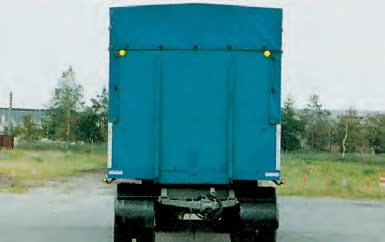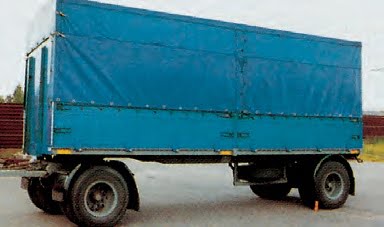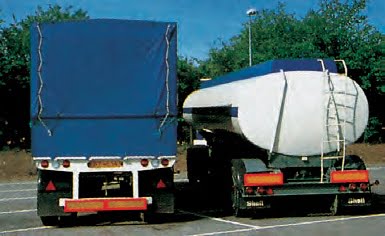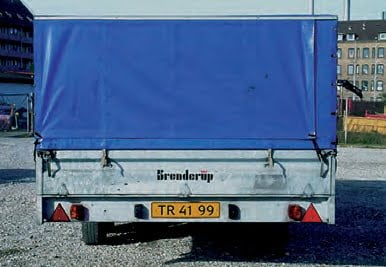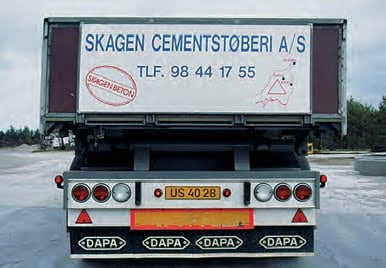large cars
Driving school
theory book
for category C - D - C/E - D/E
Large cars and lorries
3. Electrical systems, lights, reflectors, etc.
The lights on a trailer must be electrically connected to the corresponding lights on the lorry.
Any ABS brakes on a trailer must be electrically connected to the electrical system of the towing vehicle, usually through a special electrical socket.
Legal regulations on mandatory lights and reflectors
A trailer may only be equipped with mandatory and authorised lights and reflectors.
Mandatory lights and reflectors include:
- Two lights with position lights. (If the gross vehicle weight of the trailer does not exceed 3500 kg, these are only required if the width exceeds 1.6 metres).
- Two white forward-facing reflectors.
- Yellow side reflectors placed at appropriate intervals.
- Yellow side marker lights if the trailer is longer than 6 metres (the coupling device is included in the length of the trailer). Older trailers (1996) may be equipped with either side reflectors or side marker lights.
- Two lights with rear lights.
- Two lights with stop lights.
- Two rear indicators.
- At least one number plate light must be readable from a distance of at least 20 metres.
- Two red rear-facing triangular reflectors placed with the tip upwards.
- Yellow reflective plank(s) with red border.
On trailers wider than 2.1 metres, there must also be two forward and two rear marker lights, with white and red light respectively, that can be clearly seen from a distance of 300 metres without dazzling.
Position lights must be clearly visible from a distance of at least 300 metres without glare.
The rear lights must have a red light that can be clearly seen from a distance of at least 300 metres without dazzling.
Yellow side reflectors that must be approved and distributed on the sides of the trailer. On older trailers (1996), side reflectors can be replaced by amber marker lights that are clearly visible from a distance of at least 300 metres without dazzling.
Trailers must always be equipped with side reflectors and, if its length is more than 6 metres, also with side marker lights (side reflectors and side marker lights may be combined).
The coupling device must be included in the length of the trailer.
Legal regulations on permitted lights and reflectors
Permitted lights and reflectors include:
Tail lights, work lights, auxiliary tail lights, auxiliary front and rear marker lights, auxiliary side marker lights, rear fog lights, side indicators,
headlights, additional rear indicators, additional stop lights, hazard warning lights and additional reflectors.
Trucks/trailer combinations can be equipped on the sides with reflective contour markings in yellow or white and advertising or logos in a low-reflective material that can be in any colour. Trucks/trailer combinations can also be equipped with red contour markings on the rear.
Checking lights etc.
All lights must be able to illuminate.
Lamps in pairs must be of the same colour and intensity.
Lenses and reflectors must be clean and intact.
Stop lamps must provide significantly more light than rear lights.
The indicators must flash a yellow light that is clearly visible in sunlight.
Licence plate lamps must have a white light that can illuminate the licence plate. Mandatory reflectors must be approved.
Rear-facing reflectors must be positioned with the tip upwards.
Signs of failure:
Lights that do not work or work incorrectly can be caused by a fault (poor connection) in the electrical connector between the car and trailer.
If the indicators are flashing significantly faster than usual, this is usually a sign that one or more indicators are not working.
Test your knowledge
Cat. C - D - C/E - D/E - D/E - Trailers - Section 3
Select the questions you think are the right ones.
